Bundesliga MD 03 Preview: Bayern against Mainz
Mainz, on the other hand, would be happy to come away with anything from this game. A 0-3 defeat against Freiburg on matchday 01 followed by a 1-3 in their first home game against Gladbach on matchday 02, and an early first round exit in the DFB Pokal at the hands of Kaiserslautern – this season could hardly have begun any worse for Sandro Schwarz and his team.
And now they have to make the trip to Munich, of all places. Or is this actually a lucky draw? In their last four encounters away to Bayern, they won one, drew one and lost only two. Under coach Sandro Schwarz, however, they came away with two defeats, 0-4 and 0-6.
Four times Sandro Schwarz’s Mainz has faced Germany’s record Champions, four times they have lost. So on paper, there is little optimism for Sandro Schwarz and his team and they could be faced with two long, hard weeks if they leave Munich empty handed.
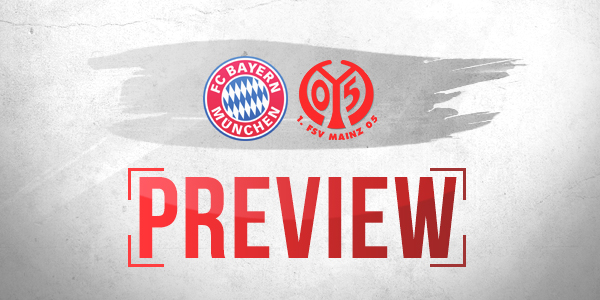
Mainz 05: quantity, not quality
Going by their on-pitch performance, Mainz did not quite have as calamitous a start as the results suggest. The team was competitive until late in both league games against Freiburg and Gladbach. Yet In both games, they conceded late goals.
Mainz’s game in possession is worth a look. The team manages to open up spaces in the opponent’s half, but they regularly lack the finishing touches. From open play, they have put 27 shots on goal, totalling an xG of 1.52, which equals 0.06 xG/shot on average. This leaves them tied at the bottom of the league with Cologne. Bayern has 17 shots on goal at 0.12 xG/shot. League leaders are RB Leipzig (0.27 xG/shot) and Leverkusen (0.24 xG/shot).
The reason for this is simple: no other team tries their luck from distance so often as Mainz 05. This is not a new development at Mainz. The team has developed a habit of shooting from distance in recent years. This season, half of their 38 shots on goal came from outside the penalty box. Not every shot from distance is a chance wasted, but as a result of Mainz’s propensity for seeking an early finish, they sometimes miss out on propitious opportunities and a more worthwhile attempt on goal.
With Courage Comes a First Success?
Even though this has been a long-standing trend at Mainz, we don’t want to overstate its significance this early in the new season. Once again, Sandro Schwarz will be tasked with eliminating the frantic edge from his game and successively substitute quantity for quality. That the club could spend almost €30 million this summer – mainly due to a €25 million transfer of Jean-Philippe Gbamin to Everton – will certainly help. Because year after year, the club is dependent on new players: the club has garnered a reputation for having a good nose for fresh talent, particularly from France. At the same time, many of these players leave only little later when they start attracting the attention of bigger clubs from Europe’s major leagues.
Despite being caught in this vicious cycle, Sandro Schwarz deserves credit for how quickly and regularly he turns his fresh talents into sought-after players. He also deserves credit for being able to establish a smooth combination play year after year despite the constant bloodletting his team has to endure. This year too the club is once again already able to string together decent passing combinations.
With a pass completion rate of 77.9% and 48% share of possession, Schwarz now has to develop a plan for the final third. Mainz has traditionally been a team apt at pressing high and attacking the second ball. At present, they appear to have put these skills on hiatus.
Will Schwarz trust the diamond?
Against Bayern, it will not be enough for the team to sit back and wait for counters on the break and opportunities to shoot from distance. Mainz would be well advised to attack and disrupt Bayern’s build-up play as early as possible. Thus, it will be important for Mainz to come up with ideas of how to stop Bayern from pushing through the center.
The run intensive diamond that Schwarz has preferred this season could be well suited for this task. Mainz’s two centre-backs and the holding midfielder of the diamond could mirror the centre-forward and the two number eights of Bayern, while the inverted constellation applies to Mainz’s forward line. The two number eights of the diamond could also pair up with the full-backs to produce a surplus of bodies on the wings.
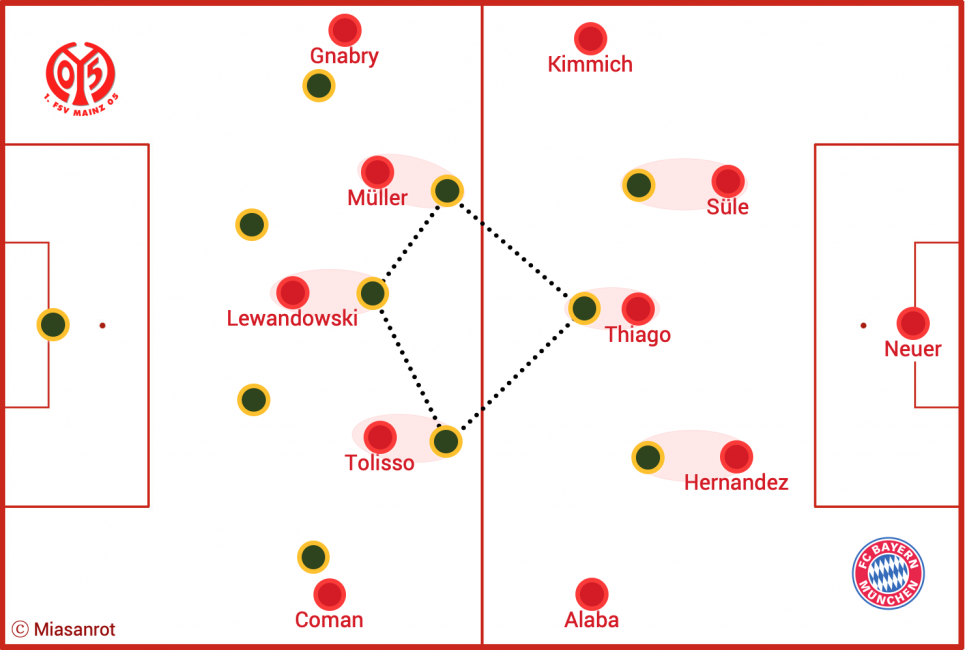
Bayern has been susceptible to individual mistakes during the build-up play when put under pressure as of late. Mainz will only have a chance to get points if they have enough courage to consistently press without relenting. For this, they will need the usual mix of aggression, willingness to run and a bit of luck.
Bayern and their six appeal
Naturally, Bayern seeks to prevent such nasty surprises. Based on Niko Kovač’s impression of their game against Schalke, all it appears to take would be a repetition of that performance. “Devoid of mistakes” and “in control for the whole 90 minutes” the coach analysed his team’s performance to have been. Whether he just wanted to bolster his team’s confidence or whether this was his real impression, nobody quite knows.
Because his team’s game was actually not quite as flawless as the coach would like the public to believe – again. Bayern were in control in the first half and towards the end of the second, but in between they encountered several spells of dangerous vulnerability where they barely escaped without conceding.
By sheer good luck and fortune Bayern got away unscathed from at least two, maybe three critical situations in their penalty area. Schalke should have been awarded at least one penalty and could have scored from open play on several other occasions. All the while, Schalke did not even play particularly compellingly. Bayern was just fragile. Compared to the season’s opening game against Hertha, the one against Schalke must be called a step backwards.
Bayern lacks attention
Gone are all the promising signs in build-up play that we praised after the game against Hertha.
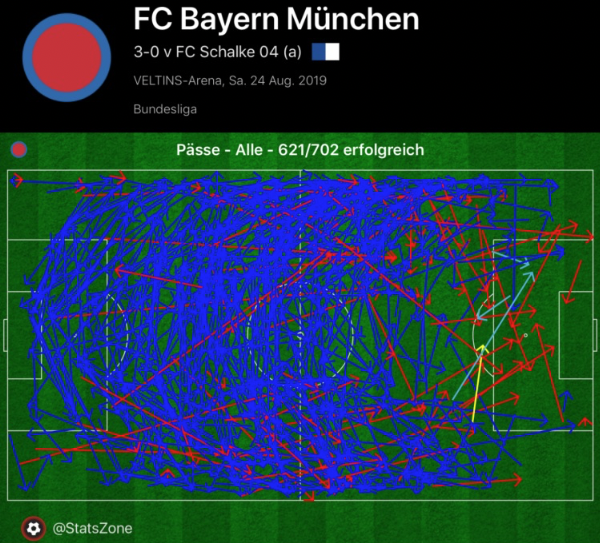
From the iOS-App StatsZone
The weekend’s pass map highlights how all of Bayern’s well-worn, old problems persist: there are only very few passes into the zone 14 (the playmaker’s zone), too many passes out to the wings, and the typical “U” of a game that lacks penetration and decisiveness in front of the opponent’s penalty area. The result: the game becomes slower, more ponderous, more predictable and allows the opponent to take the threatening edge off of the attacking efforts far too easily.
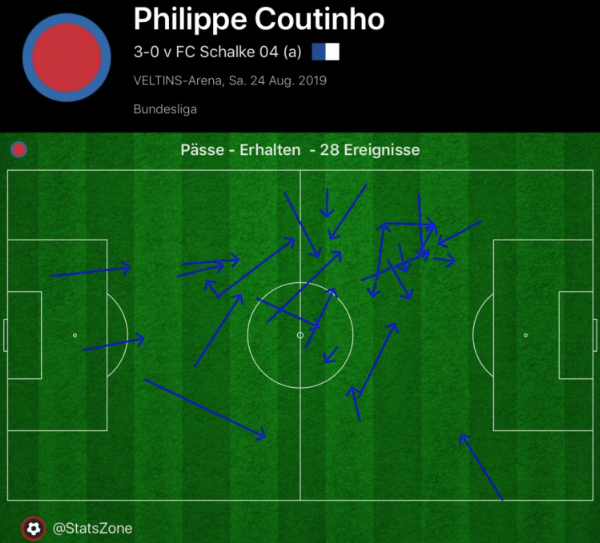
From the iOS-App StatsZone
Philippe Coutinho’s performance was a small silver lining. He consistently kept occupying the half spaces on the left. But even with him on the pitch, Bayern failed to exert any real pressure. Against Hertha, the record champion played 42 passes in zone 14 (37 successful, 10 of them in the penalty area). This past Saturday there were only 23 passes (18 successful, only 3 of them into the penalty area).
These mediocre stats were also due in part to Schalke’s performance. Schalke sat deeper and offered fewer gaps between the lines than Hertha did. Additionally, Bayern had to do without Thiago, their primary link-up player between defense and offense. But even taking this into account, Bayern’s key problems lie in their lack of attention and awareness in midfield.
Judging the team as a collective, not individual performances
Because even with Thiago as the holding midfielder and deep-lying playmaker on the pitch, Bayern has already delivered similarly disappointing performances in the past. They make it needlessly difficult for themselves because they do not pay attention to certain things that are important for the quality of their game, particularly regarding the holding midfielder and the two number eights.
If Bayern intend to establish a refined style of build-up play through the middle – which they seemed to pursue in the pre-season games – the distances between players and lines have to change, vertically and horizontally. Regrettably, the quality of their positional play has left a lot to be desired in recent years.
Joshua Kimmich acquitted himself well as the holding midfielder. He gave away only a very few balls, tried to make himself available, and switched play effectively and with precision several times. But the aforementioned issues made it difficult for him to make a difference to his team’s overall performance. This is why it is so hard to evaluate a single player’s performance individually at the moment. Thus, instead of focusing in individual players to account for their team’s performance, one should look at the team’s collective performance as a whole.
Situation analysis: challenging the opponent better
The situation right before Coutinho’s substitution allows a closer look on the problems described:
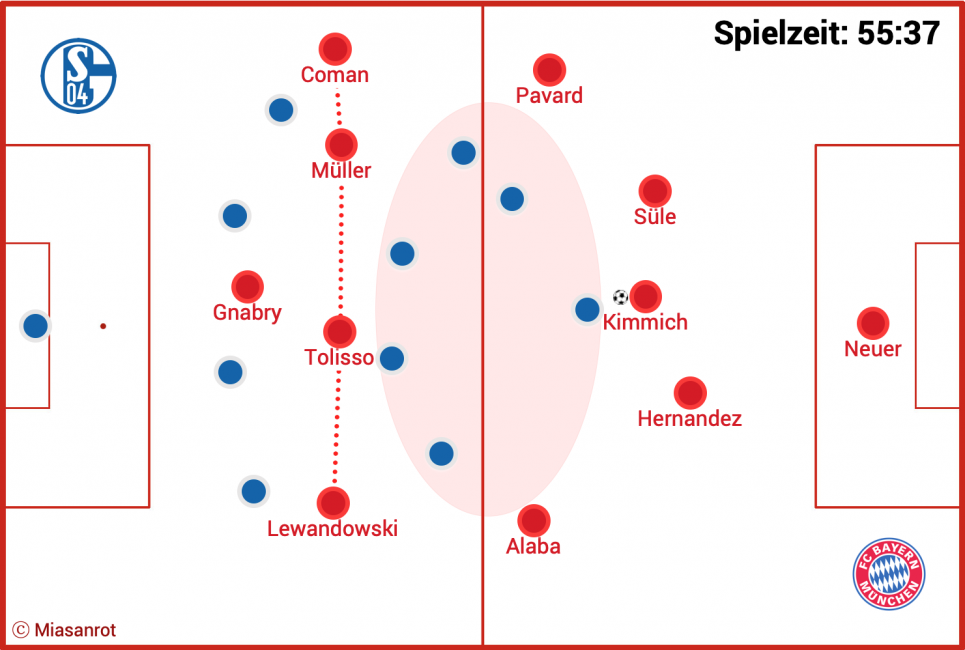
Kimmich moved back because he wanted to escape Schalke’s superior numbers in the midfield. So the first problem was that he felt cut off from his offense and thought that he had to move back to free himself. In doing so, he involuntarily created the next problem for Bayern: they were left with only three central players between offense and defense and far too many players concentrated too high up the pitch. The center-backs then essentially taken out of the game. Another problem is that entirely too many of the offensive players are neatly lined up on one horizontal line. Bayern would have had to proceed differently to gain more depth in their game. Here is one example:
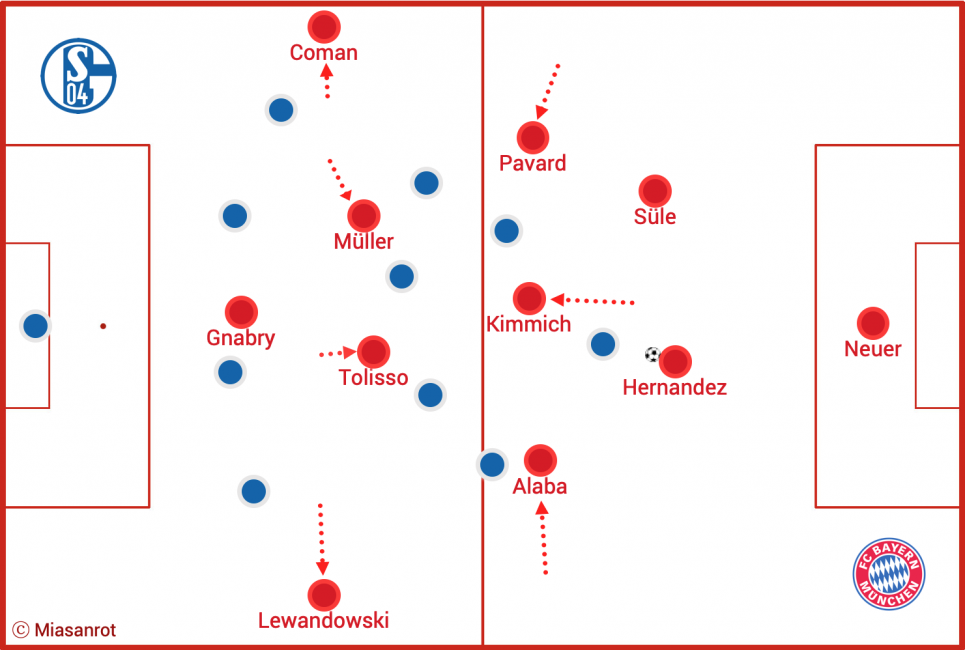
Kimmich remains in the holding midfielder position and does not retreat. David Alaba and Benjamin Pavard move slightly inside, Thomas Müller and Corentin Tolisso fall back and Kingsley Coman and Robert Lewandowski (who had swapped position with Serge Gnabry) move out to stretch the game.
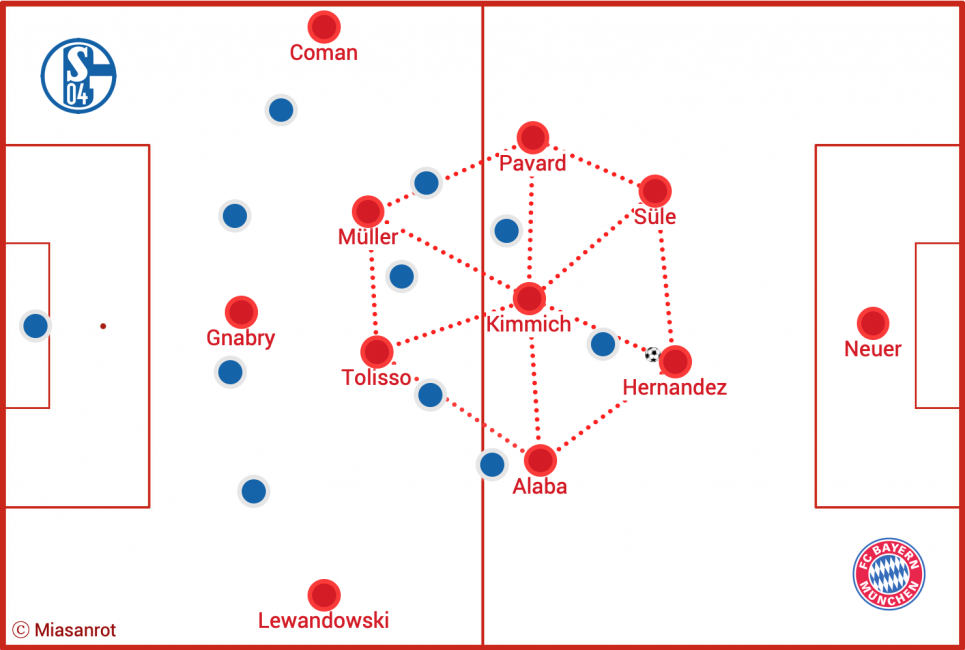
This creates a tight hexagon in the center opening up a lot of passing opportunities for Kimmich. If all players now constantly adjust their position according to Kimmich as well as the gaps in the opponent’s lines, they should be able to steadily advance the ball higher up the pitch by circulating it among themselves.
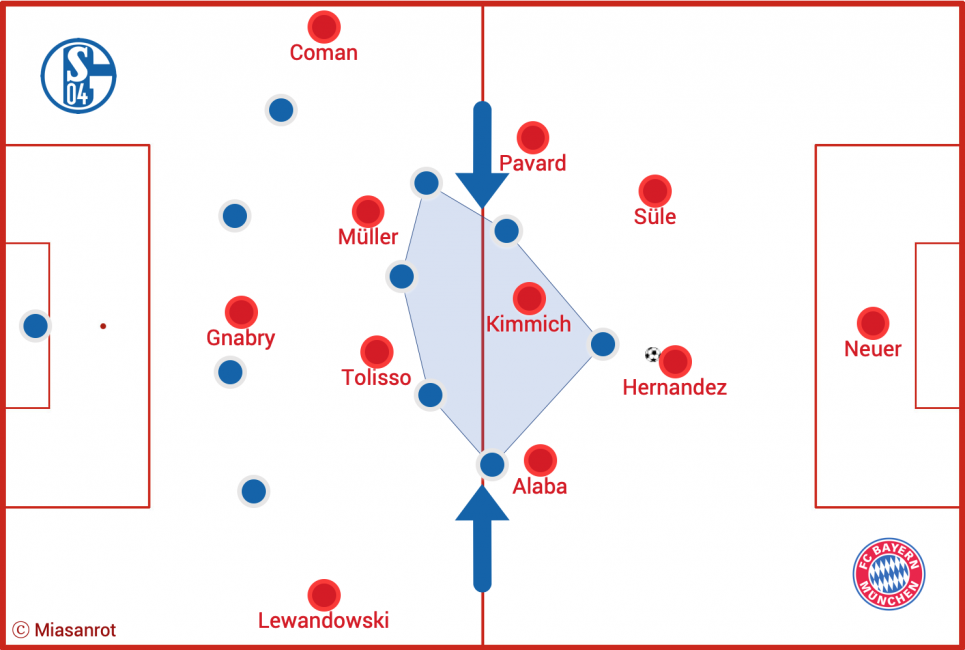
Kimmich also would have had more support against a Schalke press that by now will have become alarmed and started to more aggressively hunt for the ball. The passing distances would have also significantly decreased and the tight web of players would have added another advantage: more room for the wingers. Schalke would have had a harder time sussing out quite when the pass onto the flanks would have come.
Another imperative in this situation would have been that the number eights and the full-backs advance and close the ranks when the crucial pass forward to the attacking players occurs. This closing of the ranks would allow the team to immediately exert greater pressure with more men in gegenpressing should they lose possession. It also would provide for more passing opportunities in the final third for the player in possession.
Ideas without balance
Kovač’s idea of positioning his number eights high up the pitch does not work if they are cut off from, and without any real connection to, their defense. This was the case in the game against Schalke. And so the two players failed to build up pressure in attack or create moments of surprise. On the contrary: Bayern provoked several careless losses of possession and granted Schalke a spell of dominance after the break that almost ended in disaster.
However, there were small signs that Kovač is working on solving these issues. In the first half especially, Alaba repeatedly moved slightly inside to support Kimmich. While Alaba ventured forward in these situations, Pavard retreated slightly and formed a back three with Süle and Hernández.
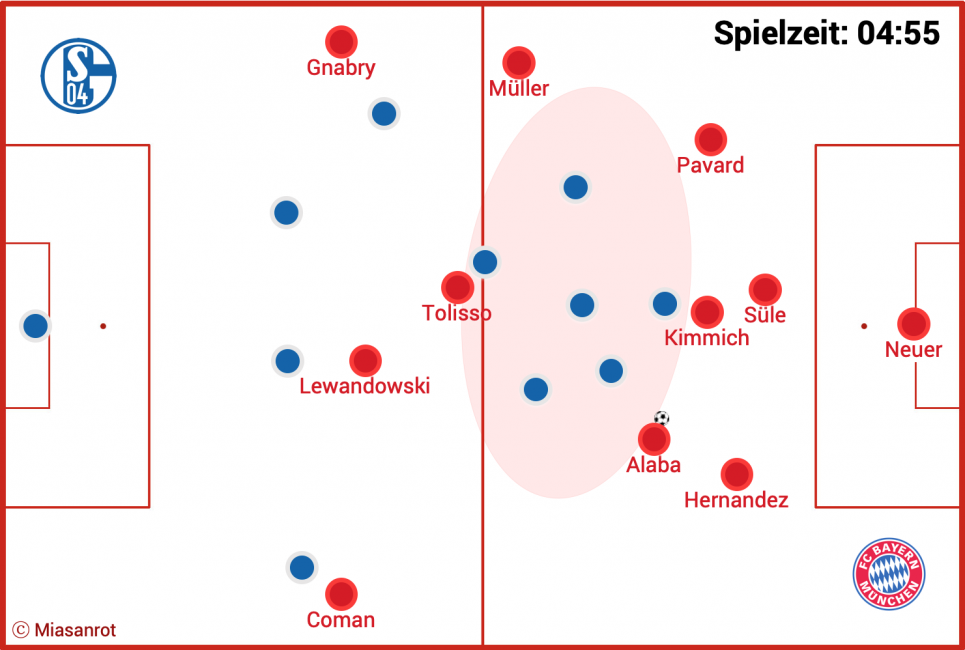
Alas, as the graphic shows, this did not always work out either. As early as the fifth minute, Bayern were struggling with their positioning. Instead of productively using the advantages of a full-back moving inside, Kimmich and Alaba deprived their back three of its key purpose and advantages. Both players, Kimmich and Alaba, should have been placed way higher. Müller also eliminates himself from the game by occupying a meaningless position on the pitch. And Schalke was not even in an especially compact shape in this situation. Alaba managed to pass the ball to Coman who had ample space for his one-on-one. Yet instead of equal numbers, a better distribution of players and use of available space would have yielded a surplus of bodies in attack.
Still a long way to go
On the whole, the Schalke match allows only for sobering conclusions. Kovač is still looking for his team’s balance. He has been struggling with this, and unsuccessfully so, for more than a year now.
One may now justly interject that perhaps Kovač is not really interested in filling his team’s obvious gaps in midfield. That perhaps he actually intends to get into the final third as quickly as possible. Yet if this were the case, questions have to be asked about his truthfulness as a coach. Because on the one hand, Kovač keeps repeating that he wants to continue Bayern’s traditional kind of football (marked by dominance, control, high rates of possession, always being on the attack). On the other hand, his style of play and the performances of his team fall desperately short of proving his ostensible intentions.
So the question remains how Kovač plans to reach these ends if doing so is indeed his intention. If the distances between his players remain so great, he will face troubles with any style. And it becomes more and more striking how these tactical deficiencies keep appearing irrespective of any particular player. Kimmich may have made the odd wrong decision in the game against Schalke for which Kovač cannot be blamed. Perhaps Tolisso and Müller are not the right players for a possession based and controlled style of play. But perhaps all these players are just not properly integrated – and if that is the case, questions have to be asked about the coaching team and their ends and means.
The way the team adjusted to Couthino coming on indicates that there might be a shift back to a 4-2-3-1 again. But in this formation too Bayern had problems to build up pressure and provide depth last season. They suffered from the opposite extreme they are facing now: stable at the back, but not enough people in offense to achieve situations of outnumbering the opponent and creating dangerous combinations.
There is no room for excuses anymore. The giant hole in midfield is the origin of almost all of Bayern’s problems – regardless of whatever strategy they favor. Will Kovač and his coaching staff finally be able to start using the midfield in a creative and productive manner instead of letting it lay bare? If he does, wild phases with his team seemingly out of control will become fewer and further between.
The problems result from a combination of a highly deficient use of spaces on the pitch and a problematic distribution of roles. There is a lot of work left to do for Bayern. The mistakes against Schalke have delivered plenty of material to demonstrate to the team what will be important for them to work on before the match against Mainz. This game will be the first to prove if the very same mistakes from last season keep being made over and over again, or if the team starts learning its lessons. Because despite of a 0-3 away win, the coaching staff and their squad should be much more worried than they have sold it to the public.



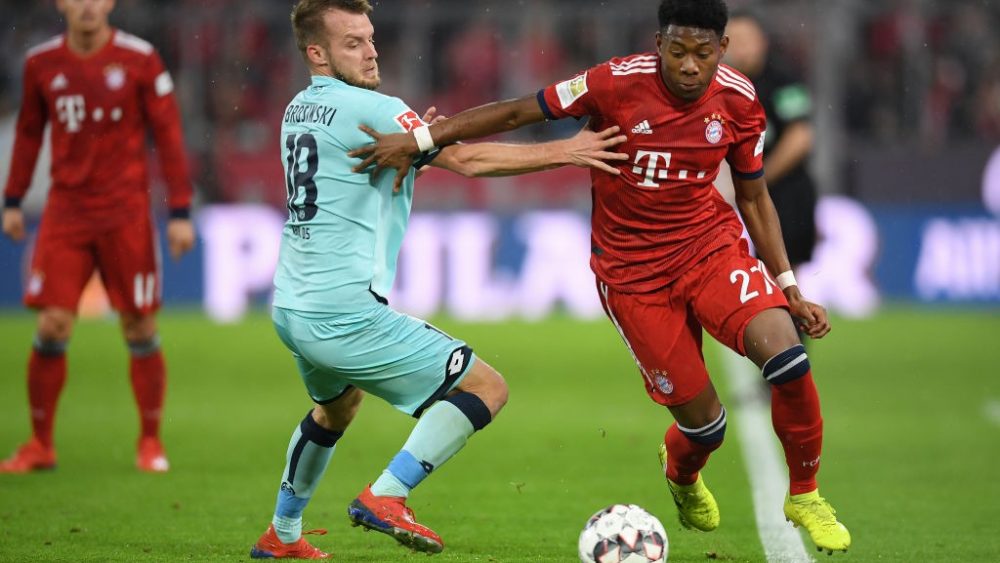
 August 30, 2019
August 30, 2019 


